Introduction
Embedded systems have become a significant part of people’s lives, although they are designed to operate with little or no human intervention. They are very popular due to factors such as low cost, compact size, and simple design. These systems now play an essential role in many devices, equipment, instrumentation, and home appliances, and this trend is likely to continue in the near future.

What is Embedded Engineering?
Embedded Software Engineering is the process of using software engineering to control devices and machines that are not traditional computers. Embedded systems are created by combining software engineering with non-computer devices.
What Is an Embedded System?
An embedded system is a microprocessor-based computer hardware system with software designed to perform a specific function, either as an independent system or as part of a more extensive system. At its heart is an integrated circuit designed to perform computation for real-time operations.
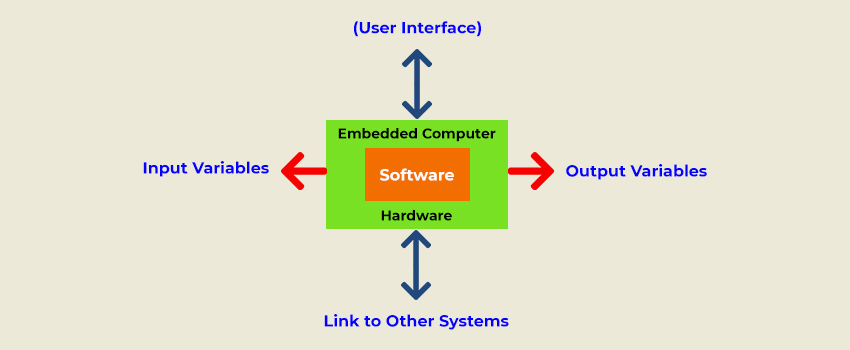
Common Features of Embedded Systems
Some of the key features of Embedded Systems are listed below:
- Embedded Systems are all task-specific. They perform the same task repeatedly throughout their lives.
- Embedded systems are created to complete a task in a specific amount of time. As a result, it must be fast enough. If a car’s braking system exceeds the time limit, it may cause an accident.
- They have a very limited or no user interface (UI). After the program is selected, a fully automatic washing machine operates independently and stops when the task is completed.
- Some embedded systems are designed to detect and respond to external stimuli—a thermometer and a GPS tracking device.

- Embedded systems are designed to be as efficient as possible. They are small in size, use less power, and are reasonably priced.
- Users are unable to modify or upgrade embedded systems. As a result, they must be highly reliable and stable. They are expected to work for extended periods without causing any problems for the user.
- Microcontrollers or microprocessors are used in the development of embedded systems.
- Connected peripherals are required for embedded systems to attach input and output devices.
- An embedded system’s hardware is used for security and performance. The software is used to implement features.
What is an embedded computer?
An embedded computer is an integral component of nearly all embedded systems. It is a set of hardware and software that is designed to perform a specific task.
Examples of Embedded Computer
Embedded computers, as compared to stand-alone computers, are integrated into other devices. Embedded Computer examples include – Digital cameras, mobile phones, music players, specialized IT hardware (such as networking hardware), and almost any type of industrial or domestic control system.
What is an Embedded Design?
The term “embedded system design” refers to a system designed with the integration of hardware and software for a specific function over a larger area. A microcontroller is essential in the design of embedded systems.
Embedded System Structure
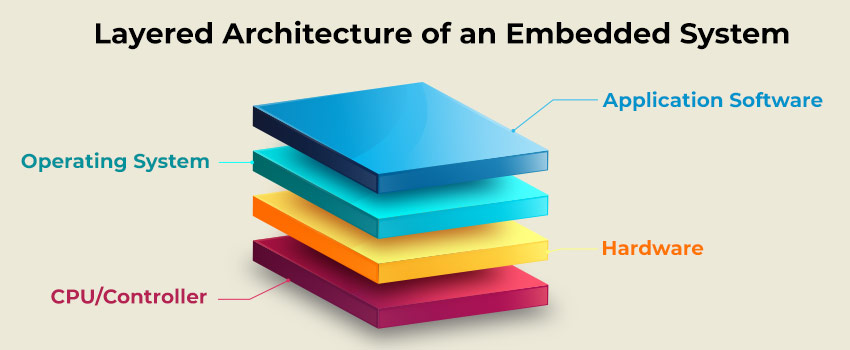
According to the Embedded Systems Structure, all embedded systems have one thing in common at the highest level: they all have at least one layer (hardware) or all layers (hardware, system software, and application software) into which all components fall.
The hardware layer contains all of the significant physical components found on an embedded board. The system and application software layers, on the other hand, includes all of the software found on and processed by the embedded system.
Embedded Hardware
The hardware layer is centered on a central processing unit (CPU), which serves as the primary system controller. A CPU can be represented as follows:
- A microprocessor with only a CPU and enough power to perform a single simple operation.
- A microcontroller, which combines a CPU, I/O ports, and RAM/ROM memory on a single chip and can perform a variety of tasks.
Other essential embedded hardware components include:
- Data storage memory devices
- Input/output (I/O) devices are used for input and output operations.
- Data transfer between hardware components via computer buses
- Sensors for converting physical data into analog electrical signals
- ADCs (Analog-to-digital converters) convert analog electrical signals (such as sound or light) into digital signals that a processor can read.
- DACs (digital-to-analog converters) convert digital signals from the processor to electrical signals.
- Actuators that enable mechanisms to function based on processor signals, such as moving a motor.
- Supplementary components (cameras, printers, scanners, keyboards, etc.)
Embedded hardware elements can be combined on a single board to form a system on chip (SoC). You can also use a more complicated board for your project — System on a Module (SoM) that integrates many chips.
Embedded Software
Depending on the device’s complexity and purpose, the software layer may contain a variety of components. A complete embedded software package consists of four parts:
- Firmware- A built-in program that is written for specific hardware.
- Operating system- It is a software that allows you to set rules and manage system resources. It includes device drivers, which provide API for higher-level software components and communicate with hardware components. There are two types of operating systems: general-purpose and real-time (GPOS and RTOS).
- Middleware – a software intermediary that allows communication between upper and lower software levels. Middleware is software that is designed for a specific operating system and sits between the OS and application software.
- Application software – A software that performs system functions directly and interacts with end-users.
Large complex embedded systems include all of these components, whereas simple embedded solutions may lack software components, such as an operating system.
Types of Embedded Systems
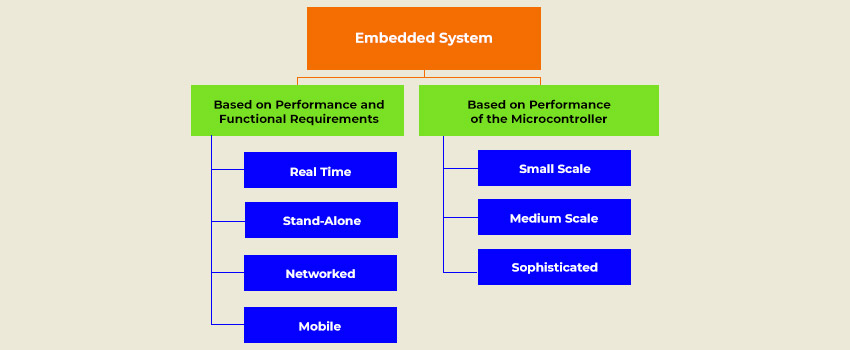
Embedded systems are classified according to the following criteria:
- Functional and performance requirements
- The Microcontroller’s Performance
Based on the performance and functional requirements, embedded systems are classified into four types.
- Real-Time Embedded Systems
A Real-Time Embedded System produces an output within a specified time frame. Real-time embedded systems are designed and built to perform a specific task in a predetermined amount of time.
- Stand-Alone Embedded Systems
Stand-Alone Embedded systems can function independently. That is, they are self-sufficient and do not rely on a host system. Stand-alone embedded systems are designed so that input is received, processed and the desired output is produced.
- Networked Embedded Systems
Networked Embedded Systems rely on a connected network to complete their tasks.
These systems are made up of interconnected components such as sensors and controllers. Many of these systems are powered by general-purpose processors.
- Mobile Embedded Systems
Mobile Embedded Systems are those that are small in size and can be used in smaller devices. Because of their small size, they are commonly found in mobile phones and digital cameras. However, they frequently have memory limitations and a poor user interface.
Microcontroller Performance-Based Embedded System
Embedded systems are classified into three types based on the performance of their microcontroller.
- Embedded Systems on a Small Scale
Small Scale Embedded Systems are typically designed and built with an 8-bit microcontroller. A battery can power this microcontroller.
- Embedded Systems on a Medium Scale
A single 16-bit or 32-bit microcontroller, or multiple microcontrollers linked together, is used in a Medium Scale Embedded System. Many people dislike these systems because they have a lot of hardware and software complexities.
- Advanced Embedded Systems
Sophisticated Embedded Systems frequently use multiple algorithms, resulting in hardware and software complexities. They often require a configurable processor and a programmable logic array.
Application of Embedded Systems
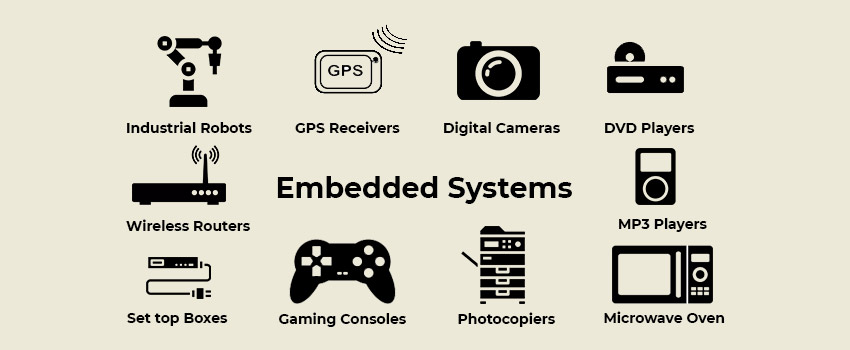
Smart Home
Electronic devices and household appliances such as TV and music systems, digital cameras, smartphones, gaming consoles, air conditioners, fridges, coffee machines, and vacuum-cleaning robots are vivid examples of embedded software used in modern homes.
The concept of an intelligent home emerged when such devices became internet-enabled, and users could manage them remotely via wireless connectivity.
Smart Cities
In cities all over the world, various electronic devices and IoT systems are in use. By combining into vast smart networks, they form a new ecosystem known as a “smart city,” which exists solely to support security and streamline processes in large areas populated by millions of people.
Smart parking, surveillance systems, traffic control systems, pollution monitoring solutions, interactive kiosks, and a variety of community services all rely on embedded technology.
Medicine
The use of embedded systems in healthcare is now widespread. A variety of wearable devices and diagnostic systems allow patient health monitoring, data collection, storage, and analysis.
From a simple electronic thermometer to the more complex ECG and MRI machines, specific built-in programs work to benefit doctors and patients everywhere in medical equipment.
Automotive Industry
Onboard embedded systems are literally crammed into a modern car. Following are some examples:
Anti-lock braking systems, automatic transmission, blindspot detection, cruise control, and various sensors are designed to make car movement safer and prevent accidents.
Fuel control systems keep track of how much fuel is used.
The emission control technology is intended to reduce air pollution.
Driving is made more comfortable by heated seats, climate control, and in-car infotainment systems.
As a result, the primary goal of embedded software in automobiles is to provide safe, comfortable, cost-effective, and environmentally-friendly driving.
Manufacturing
Manufacturing, one of the world’s largest industries, has long been impacted by technological advancements such as embedded software. However, because of the active integration of robotics, IoT, AI, and Big Data into production processes, we can now call it smart manufacturing.
Dozens of devices, ranging from small sensors to large, sophisticated units, can be found at any factory. Their duties range from online monitoring and remote control of manufacturing equipment to data collection and replacement on the assembly line.
Aerospace and Military
The importance of high-performance sensors, navigation, and communication solutions in aviation, space, and military activities cannot be overstated. Embedded and IoT solutions are critical in this industry because they are in charge of planes taking off and landing and satellites circling the Earth while sending and receiving signals.
Best Languages and OS for Embedded Systems Programming
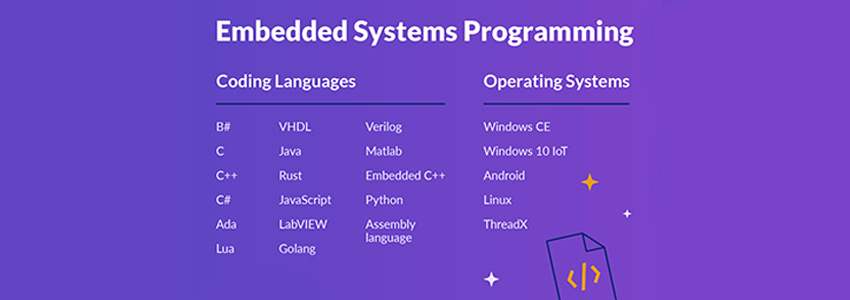
C and C++ :
Built-in systems, which differ significantly from general computer-based programs, necessitate a diverse set of tools and operating systems for programming and operation.
C and C++ programming languages have traditionally been used to create software that is embedded in a hardware chip. Their primary advantages are:
- Speed
- The ability to access low-level system components
- The use of little memory by the compiled programs
C#:
C# is an object-oriented and structured programming language derived from the C family. It’s also a good choice for embedded and IoT solutions because C# programs can run on various architectures.
Assembly Language:
Assembly language is famous for low-resource systems because it directly translates code into machine code that hardware can easily interpret. In addition, the language is quick and efficient in terms of memory usage.
Java:
Java, one of the most popular languages for desktop software, is also used to create excellent programs for embedded systems. Developers can create portable applications that are compatible with various types of hardware by leveraging its powerful libraries and the Java Virtual Machine (JWM).
Python:
Python, an interpreted language, has gained popularity as a computer science and embedded computing tool in recent years. It is short and easy to read, which speeds up the app development process. In addition, python can collect, store, and analyze massive amounts of data from real-time embedded systems by utilizing artificial intelligence algorithms.
Python may be most effective when used as a communication intermediary between the user and the embedded system they interact with. Using Python embedded systems to send messages allows the user to automate testing.
Windows CE and Windows 10 IoT:
There are numerous suitable operating systems available. Because it was specifically designed for handling industrial controllers and automobile computers, Windows CE plays a significant role in powering various built-in systems. However, it is becoming obsolete, and you should consider replacing it with Windows 10 IoT.
Linux and ThreadX:
Open-source Linux, like Android for mobile devices, is a traditional operating system for smart appliances. Among the smart solutions for managing smart objects is ThreadX, a real-time operating system (RTOS).
What is Embedded Software?
Embedded software applications are specialized programs that control specific functions of non-PC devices, either as part of a microchip or as part of another application that sits on top of the chip. Unlike PC applications, which can be installed on a wide range of computer systems and customized to provide varying levels of functionality, embedded software has fixed hardware requirements and capabilities. It is designed specifically for the device on which it runs, with processing and memory constraints tied directly to the device’s specifications.
Benefits of Embedded Systems
- Smaller in size and faster to load
- More focused on a single task 3. simple to manage
- Low cost
- Use fewer resources.
- Because these operating systems are dedicated to a single device, their performance is high, and they consume fewer resources such as memory and microprocessors.
- To upgrade assets such as memory and chips.
- It aids in the development of item quality.
- It can withstand a wide range of weather conditions.
- Less likely to repeat mistakes.
- To provide a consistent reaction.
- It has no user interface and less repetition.
- There isn’t a lot of information stockpiling.
Challenges of Embedded Software Development

- You can’t make any changes, improvements, or level-ups after you’ve created the installed framework.
- It isn’t easy to take a backup of documents that have been implanted.
- If there is a problem with the framework, you must reset all settings.
- Investigating is Harder.
- It is hard to transfer information from one framework to another.
- Equipment constraints, as a result of making it for a specific task.
- Less force provides sturdiness.
- Memory assets are restricted.
- To necessitate more outstanding improvement efforts to plan an installed framework.
- It is necessary to wait for an ideal opportunity to advertise.
Stability
In many cases, real-time response and stable behavior of the equipment under all conditions are lifesaving, and developers are in charge of this functionality. Therefore, they must design programs so that devices operate consistently within the constraints of the available resources and in the face of changing environments.
Design Constraints
Devices should become smaller but more robust in response to market demands. Unfortunately, it is an increasingly difficult task for software engineers to pack more computing capabilities into a smaller piece of hardware.
Security
Personal data security has become a hot topic in the digital world, where any object connected to the internet can be vulnerable to cyberattacks. However, embedded security is one of the most challenging challenges for developers, as more stringent QA and testing expertise and security mechanisms for protecting built-in solutions are imposed.
Difference Between Firmware, Embedded Software, and IoT
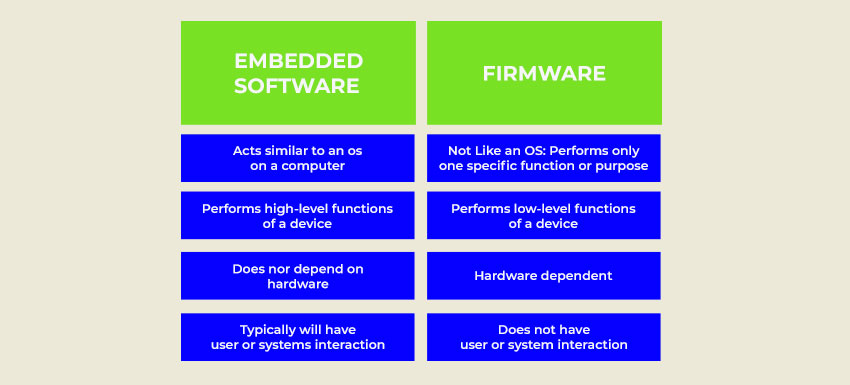
- Firmware is a program instruction stored in the memory of a single-purpose electronic device and performs low-level functions such as signal conversion. It is written in low-level languages (such as C or assembly) and then translated into machine code so that the hardware of a specific device can read and execute it.
- Previously, this type of software was stored in EPROM (erasable programmable read-only memory) chips, making it difficult, if not impossible, to reprogram or update the firmware. It is now more commonly stored in flash memory, where it can be easily updated.
- Typically, the firmware does not need to be updated because it is a permanent program for consumer appliances (e.g., refrigerators, ovens), computer components (e.g., video adapters, hard drives), and peripherals (e.g., printers, scanners).
- Embedded software, like firmware, is explicitly designed for a given device. On the other hand, embedded software is more sophisticated and performs high-level functions such as data processing and interaction with other devices because it is written in high-level languages such as Java, C++, or Python.
- While firmware can perform tasks without using an operating system, embedded software necessitates a specialized OS.
- The program files for embedded software are stored in the file system of a given device and then extracted to random-access memory (RAM) for execution.
- When an embedded system is connected to the internet, it becomes an IoT device. As a result, the Internet of Things comprises various physical objects that have integrated software and a network connection and can be controlled and updated remotely.
- Because of the rapid pace of IoT development, almost any object can become a connected device.
Living Under the Control of Devices
Is it a good or bad thing to live in a world where machines know more about you than you do and where machines can control almost everything? We don’t know what the answer is, but we know that progress cannot be halted. Instead, we must adapt to the new reality in which embedded system development has become necessary for businesses and everyday life.
If you require assistance with your embedded project, Brainvire’s highly experienced specialists are available to assist you.
FAQs
The most popular programming languages in embedded systems are C and C++, C#, Assembly Language, Java, and Python.
According to experts, the C programming language is the coding language used in about 80% of all embedded systems
Is Python used in embedded systems?
Yes. Being an interpreted language, Python has gained popularity as an embedded computing tool. However, it may be most effective as a communication intermediary between the user and the system they interact with. Using Python to send messages allows the user to automate testing.
Start by identifying the purpose of your product and determining the requirements. Make sure you document the technical specifications. Decide whether you need a user display and then develop a prototype. Now, design a system architecture on which the product will work. Then, select the operating system. Choose the processor and peripherals along with the development platform. Now, develop the final prototype. Code the embedded product, test, and debug. Verify it on the host system, then the target system.
Related Articles
-
Power Up your Enterprise with Microsoft Power Suite
Microsoft is constantly evolving by incorporating new solutions for the modern age. This dynamic transition makes the giant company stay in the race, leading the IT industry. Recently, Microsoft Development
-
Will Microsoft Teams Replace SharePoint Intranets?
During the initial phase of the COVID-19 pandemic, when businesses suddenly needed digital workspaces to support a remote workforce, the company’s intranet became an inseparable tool for communicating the latest
-
Microsoft PowerBI: The Most Effective Business Intelligence tool for Business
Ensuring all business procedures are managed properly seems a huge task! However, ever since digitization, data has played an integral part in the success of businesses. The challenges faced in




